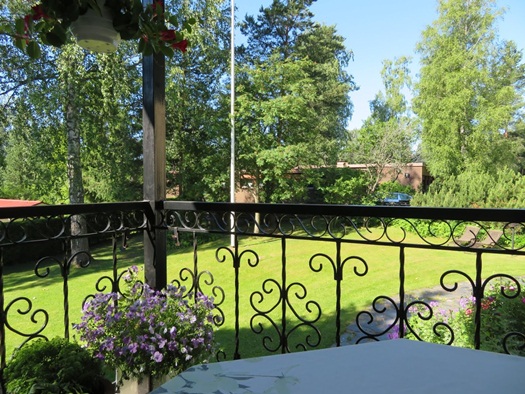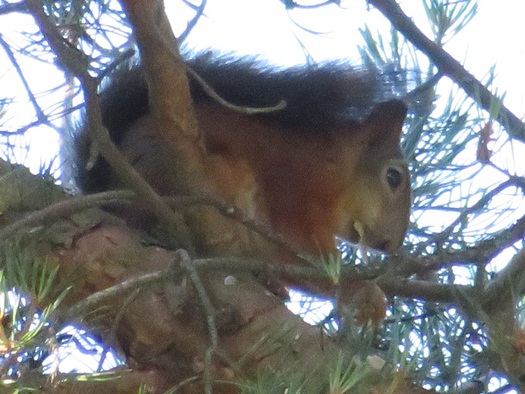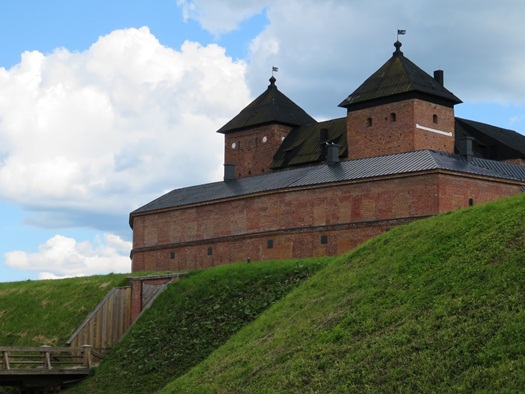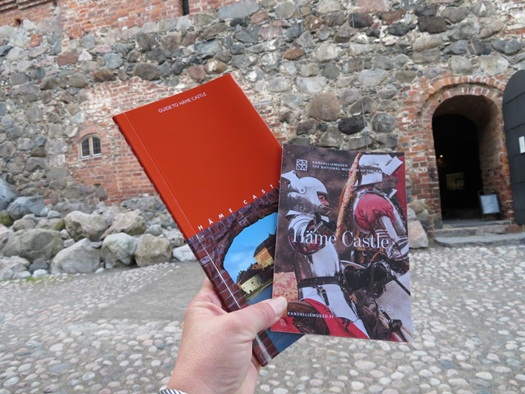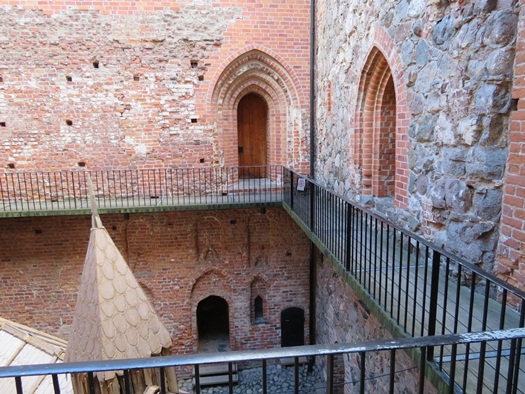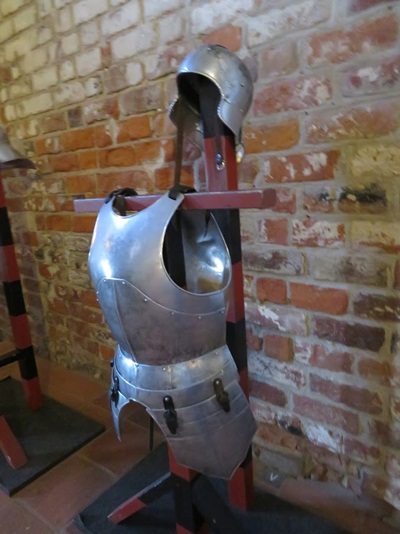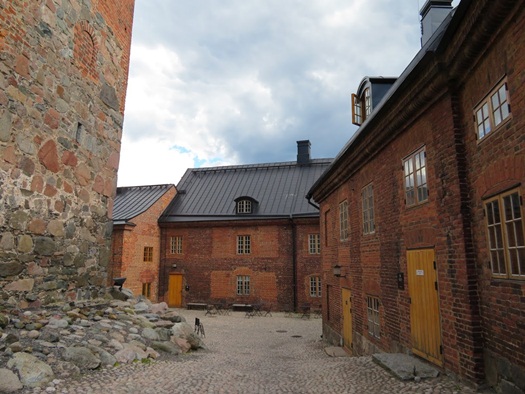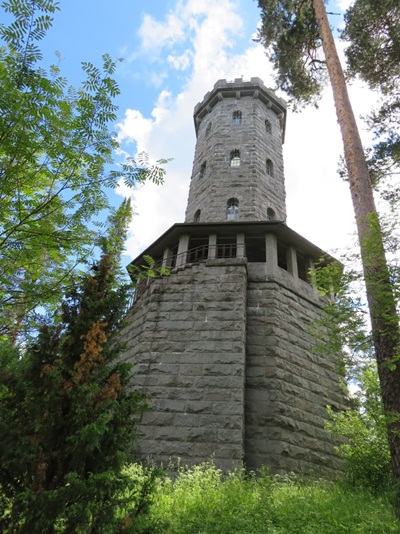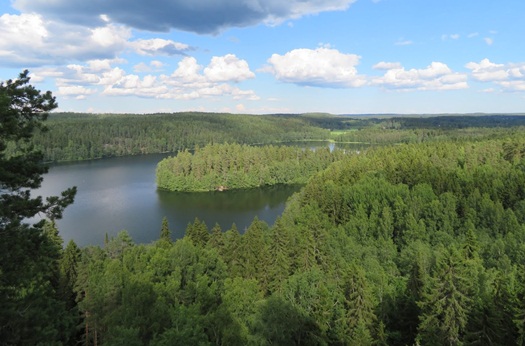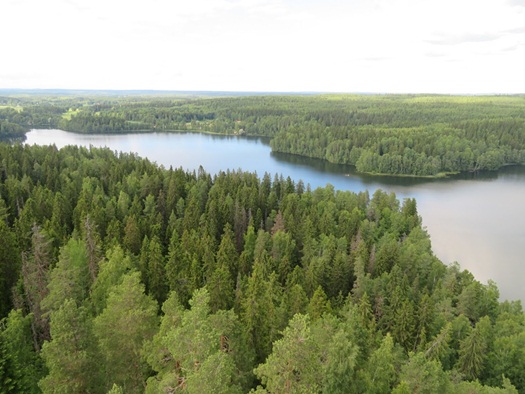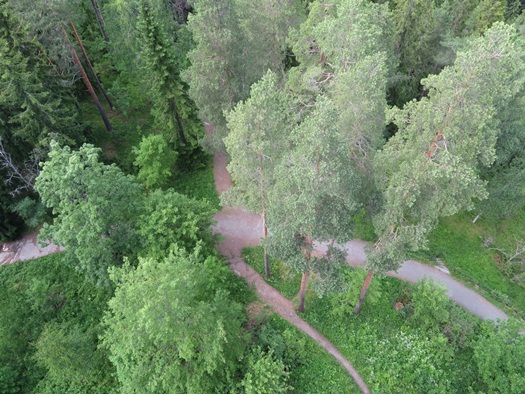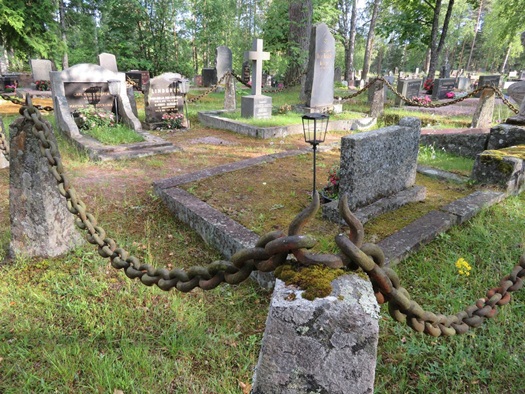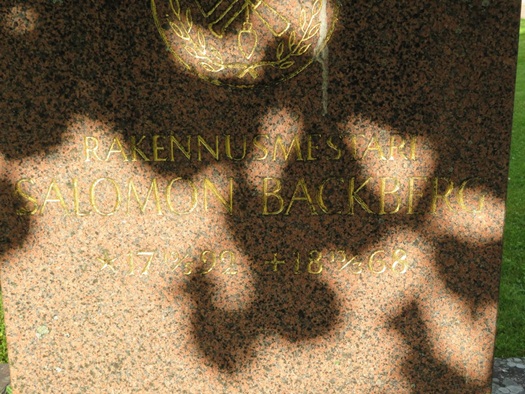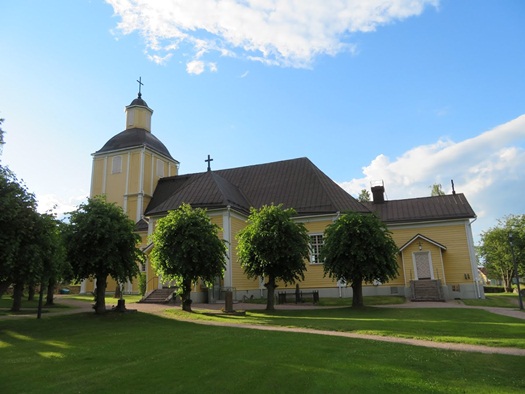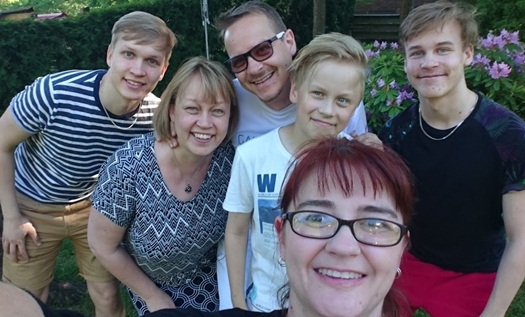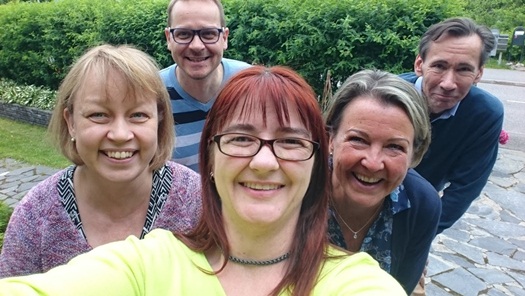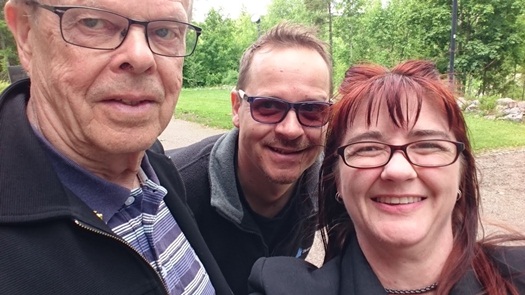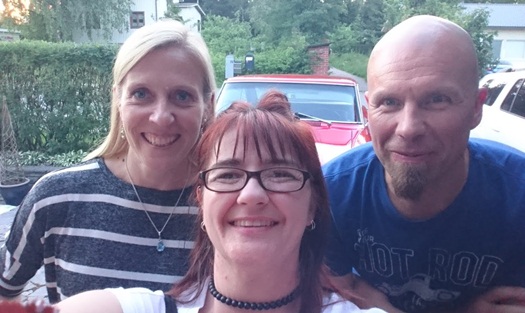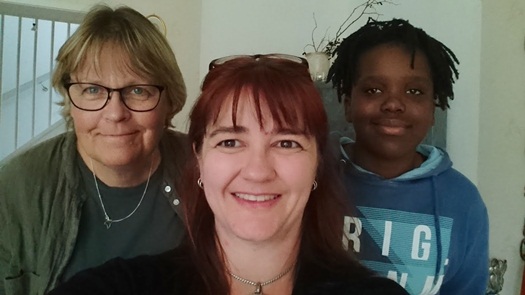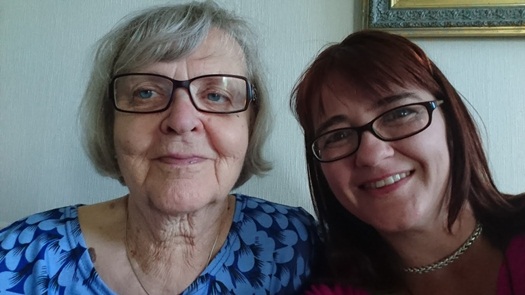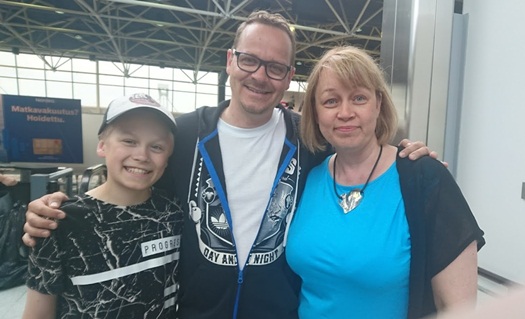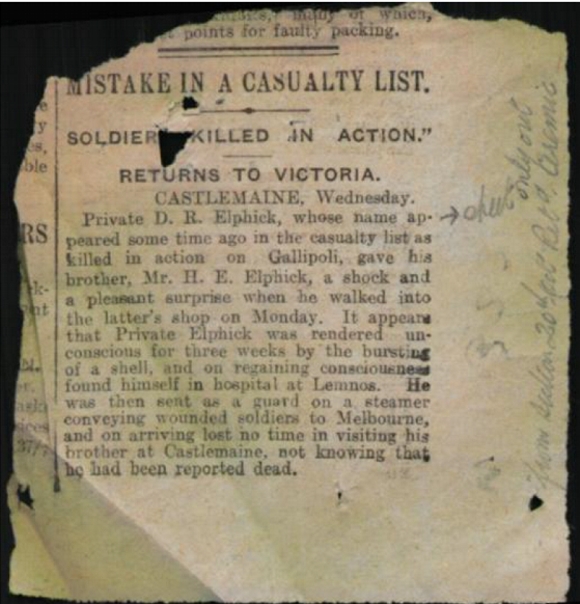Finland Day 11 & More: Pen-friends, a Castle, Giant Forests, Graves and FAMILY!
This post completes my the report of my trip to Finland. To say that it has been the trip of a lifetime is an understatement. It has been truly extraordinary in so many ways, and while I’m still jetlagged, and haven’t caught up on work that piled up while I was away yet … I’m sure I’ll be back sometime, but not next week.
Anyway, after coming back from the island yesterday it was nice to have a quiet start to Sunday enjoying the sunshine and watching the squirrels in the trees while I had breakfast … before heading out for the afternoon and evening where I got to see a whole heap more of Finland. Seriously, how big is this country? It really is tiny on a map, but obviously is bigger than it seems!
Sunday 9 July 2017 – Today was yet another exciting day in Finland (they all seem to be) … as it’s the day that I met my pen-friend, Heli for the very first time in person. But more than just a pen-friend, she’s my 4th cousin once removed. So she’s family! We started writing many years ago (ok, ok, quite a few years ago. Back in the day when letter writing was actually a thing, and it didn’t cost a fortune to post a letter either). Anyway, we arranged to meet up, and she and her partner took me to see a whole lot of Finland for the day. It was a wonderful day with great company, and great sights along the way.
First stop was Häme Castle at Hämeenlinna and this is one of Finland’s medieval royal castles. It is believed to have been built at the end of the 13th century. We’re talking the late Middle Ages era – that’s about 500 years before the First Fleet arrived in Australia! It’s not just OLD, it’s seriously ANCIENT.
Anyway back to the castle which is a museum now, and it showcases hundreds (if not thousands) of artifacts that they’ve found on the castle grounds, one of them is an chess set. And I found this description (fortunately in English) about chess very interesting …
CHESS – A Knight also need brains!
This chessboard is a replica of a game found in Häme Castle. The original chessboard and chessmen are on display on the third floor of the castle. Chess was one of the chivalry skills a knight was expected to master in order to become a true knight The game of chess was like medieval society in miniature. The king and the queen represented the monarchy, and all the other members of society had to defend them.
And if you ever want to try on a suit of armour, Häme Castle is the place to go. I didn’t, but I’m kind of regretting it now, as how many other opportunities to do so am I likely to get? Maybe I’ll have to do it next time.
The next stop was Aulangon Puistometsä, which translated means the Aulanko Park Forest, and this is truly spectacular. They say that Finland is a land of forests and lakes, which is what I saw when I flew in. And it’s also what you see from the tower at Aulangon.
After that, we drove to Hausjärvi to meet Heli’s parents and have a lovely afternoon tea, as well as visit the local cemetery since there’s a whole bunch of reli’s buried there too.
One interesting grave we found was for Salomon Backberg (b. 1792, d. 1868). He is a brother to my 4x great grandpa Joseph Backberg. And it seems that Salomon was the master builder of the local church at Hausjärvi, and because of that, he has a grave very close to the church itself. Sadly I didn’t get a good photo of the headstone due to the sun shining at that time of day, still it was great to see.
So after a day castles, forests, cemeteries, afternoon teas, and lots of travelling … the end of the day came and it was time to go home (my Finnish home).
And I think the busy days are catching up with me, and it’s probably just as well that I didn’t have any real plans for Monday or Tuesday. Monday was mostly resting, and Tuesday was a day to pack up, then head off the the airport and head on home. Sadly all good things come to an end, my trip to Finland too.
But to all the cousins who I stayed with, and others I met with while in Finland … THANKYOU, THANKYOU, THANKYOU for making me so very welcome, and making me feel like a part of your family. As well as taking the time to show me your beautiful country. Big HUGS to you all!! And I look forward to catching up with you all again next time …
To those following along, I hope you’ve enjoyed learning a little about Finland as much as I did.
And here’s just a few family photos to finish of my collection.
“Dead” Soldier Returns
Anzac Day. The day to remember those who fought for our country. Some survived. Many didn’t. And in reality those that returned were changed forever.
It was while I was going through the military records of Arthur Vincent Elphick (Mr Lonetester’s great grandpa), that I kept seeing the name of Donovan Russell Elphick written in his records. Arthur was one of twelve children in the family, and Donovan was his youngest brother.
On checking Donovan’s military records on the National Archives of Australia website, and reading through the dossier, one page in the record jumped out at me. But firstly, some background information …
Born in Prospect, South Australia, but living in Western Australia, 24 year old Donovan signed up to serve his country in January 1915. After training in Western Australia, he was assigned to the 5th Reinforcements 11th AIF, and sailed to Egypt in June 1915, and was obviously in the thick of it from arrival, as within a week of arriving he was in hospital suffering from “deafness”.
From here, I’ll let you read the article as that explains it all …
The above article came from a Victorian newspaper, and is dated 20 October 1915. This story was repeated in numerous Victorian, South Australian and Western Australian newspapers over the weeks following. As you can imagine it was quite a story. And to say that it shocked his brother (Harold), when he walked in would be an understatement.
Donovan was one of six boys in the family, with three going off to war. Sadly only two returned.
And while Donovan Elphick did survive World War 1, he died in Perth on 25 December 1936, aged just 45.
Sudden Death at the Railway Station
Some days just don’t go as planned, and 22 June 1869 was certainly one of those day for the Elphick family of Adelaide.
There’s certain words when researching that grab a researchers attention. One being the phrase ‘sudden death’ with another being ‘inquest’. Both of these we terms I came across in the newspapers on Trove, when looking for info on Mr Lonetester’s 3x great grandpa, William Kennard Elphick.
I imagine that Tuesday the 22nd of June 1869 started out as a fairly standard day for the Elphick family of Adelaide. William Kennard Elphick was out and about, and made his way to the Adelaide Railway Station on North Terrace by late afternoon, either to head out or head home. However that’s when tragedy struck.
While walking down the stairs William collapsed, and died …
INQUEST ON MR W.K. ELPHICK
On Wednesday, Mr. T. Ward, J.P., held an inquest at the Adelaide Hospital, for the purpose of ascertaining the cause of the death of William Kennard Elphick. A Jury of 13 having been empanelled, and Mr. J. M. Dowie chosen foreman, the following evidence was taken, after the body had been viewed:— James March Stacy, bootmaker, said yesterday afternoon about 4.20 he was at the Railway Station. Saw a crowd assembled carrying the deceased, whose body he had just seen in the dead-house. Recognised it as that of W. K. Elphick, late of the Burra Mine. Some females bathed his head with cold water. Felt his pulse, and found only one pulsation. Then placed his hand on the heart, which had ceased to beat. Dr. Phillips then came in. Left the deceased in charge of the police, and afterwards communicated with his friends. By a Juror—The cold water was applied whilst he was feeling the pulse of the deceased.James Phillips, surgeon, said he had made a postmortem, examination of the deceased, and on examining the heart found certain portions of it in a greatly dilated state. One part in particular was excessively attenuated. There was fatty degeneration of the structure of the heart, and the arteries which supply the tissues of the heart with blood were ossified. Found also the surface of the brain in a congested state. There was a sudden cessation of the action of the heart from want of power to carry on the circulation. This was undoubtedly the cause of death.
Herbert D. Gouge deposed to being at the Railway Station on Tuesday, and seeing the deceased coming down the terrace towards the station. He came outside, and as witness was about to speak to him, deceased made a plunge forward. The messenger of the Hospital came up and helped witness to carry him into the waiting-room. He did not speak, but groaned heavily once or twice. Dr. Phillips arrived about 10 minutes afterwards. By a Juror—Deceased did not appear to have been walking fast. The Coroner then summed up, and a verdict to the effect that the deceased died from disease of the heart was returned. [The South Australian Advertiser, p. 3. 24 June 1869. http://nla.gov.au/nla.news-article31990554]
It is obvious that William Elphick was someone of note, as every South Australian newspaper that is currently on Trove, has details of his death, and inquest. Mind you having lived and worked not only in Adelaide, but also at Burra, and in Western Australia as well, it’s not really that surprising.
But finding this info was a surprise, and a sad end to one of Mr Lonetester’s emigrating ancestors. William together with his wife arrived on the “Plantar” ship in 1839, after a unbelievable 6 month journey. It took longer than the regular 4 months, as the captain was incompetent as got lost on the way, missing a port, and then had to detour elsewhere to get supplies. Not only that, but the crew mutinied, so a new crew had to be found … and so on. It’s truly stranger than fiction tale, but it happened. Details of the voyage can be found in a shipboard diary that a fellow emigrant wrote.
![Adelaide Railway Station, North Terrace, 1870 [From the State Library of South Australia, Number: B.....]](http://www.lonetester.com/wp-content/uploads/2017/04/Adelaide-Railway-Station-1870-SLSA-580.jpg)
Adelaide Railway Station, North Terrace, South Australia, 1870
[Courtesy of State Library of South Australia, B 69476]
1 Name. 61 Variants
Anyone who’s been researching been researching for longer than a week will know that name variants play a big HUGE part in research. Both with first names, and surnames. Figuring out how names were potentially spelt (or ‘spelled’ for my North American readers) can be the difference between finding them or not.
I’m not going to go into the in’s and out’s of name variants, but rather I wanted to highlight two particular surnames, and all the variants that I’ve found for them so far. There’s 61 of them for one, and 31 for the other. And truth is, I really wouldn’t be surprised if more show up.
So let’s start with ELLIOT. This is one of Mr Lonetester’s branches, while ELLIOTT (with two “Ts”) is one of mine, with no connection that I know of between them at this stage. We all know that there are numerous variants of Elliott: one “L”, two “Ls”, one “T”, two “Ts”, but what I didn’t realise is just how many more there really are.
One thing I like to do when beginning searching a new surname is to note down all the variants. That way when I’m searching, be it a website, a book or records, I can look for them all, and see what I come up with.
Mr Lonetester’s ELLIOT family possibly came from Sussex (that’s still to be verified), but I headed (online) to the Sussex Family History Society to browse around and see what they had. Now they have the coolest thing on their website, and that’s the Sussex People Index. In their words …
The Sussex People Index consists of any names that anyone can submit from anywhere – the only condition is that the event reported must happen in Sussex and there must be an identifiable source (not a website please). Wills’ beneficiaries witnesses and lawyers, information from Birth Marriage or Death certificates, tax records, settlement orders, masters and apprentices, landowners, licences issued to publicans, magistrates, churchwardens, names taken from a book which has been indexed, etc. Please not baptisms, burials, memorial inscriptions, census, or pre-1837 marriages which all have their own indexes. There are 120,000 entries referring to 230,000 people with 11,730 surnames (excluding variants).
So anyone can look at the list of surnames, whether you’re member or not, with members being able to log-in and check the details (entries for each name). Now I am a member, but have forgotten my log-ins, so will follow up on that one later, but I was able to use the surname list to create a list of alternate spellings which was handy.
My list of variant spellings for ELLIOT/ELLIOTT are:
Eleot, Eleott, Elicot, Eliot, Eliote, Eliots, Eliott, Eliotte, Ellioit, Ellioitt, Elliot, Elliote, Elliott, Ellliott, Elloit, Elloitt, Ellot, Ellott, Ellyat, Ellyate, Ellyatt, Ellyet, Ellyett, Ellyot, Ellyott, Ellytt, Elot, Elyat, Elyatt, Elyeat, Elyet, Elyete, Elyett, Elyot, Elyote, Elyott, Elyotte, Elyout, Leliat, Leliet, Leliot, Leliott, Lelliat, Lelliatt, Lellicot, Lelliet, Lelliot, Lelliott,Lelloitt, Lellut, Lellyett, Lellyot, Lellyott, Lelyet, Lelyot, Lelyoth, Lelyott, Lylliot, Lylliott, Lyllyatt, Lyllyott.
And while I was there, Mr Lonetester’s ELLIOT married an ELPHICK (from Sussex), so I created a variant list for Elphick as well. Again, I was blown away by the number of variants that there are. 31 just for Elphick, who knew!
My list of variant spellings for ELPHICK are:
Elfeck, Elfecke, Elffeck, Elffecke, Elfhick, Elfic, Elfick, Elficke, Elfig, Elfigg, Elfrick, Eliphicke, Ellfeck, Ellfick, Ellpeck, Ellpeheg, Ellphick, Elpheck, Elphecke, Elpheke, Elphic, Elphich, Elphicke, Elphik, Elphycke, Elpick, Elpiiick, Elpphick, Elprick, Elspick, Lphick.
So to anyone that says “my family never had any variant spellings”, I say “rubbish”. There’s always name variants. Sometimes it’s on purpose, sometimes it’s a transcription error either by the person who created the record way back then, or by someone transcribing it more recently. Names were so often written as they sounded, rather than a strict spelling, and combine that with various accents, and you can see why there’s so many variants.
Whether you use the Sussex People Index list or any name other list, to create your own name variant list, is entirely up to you.
But this is just a reminder to keep name variants in mind when searching.

